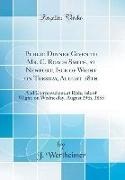Read more
Excerpt from Public Dinner Given to Mr. C. Roach Smith, at Newport, Isle of Wight on Tuesday, August 28th: And Conversazione at Ryde, Isle of Wight, on Wednesday, August 29th, 1855
Cxploration was proceeded with. The cemetery presented the appearance of a newly dug and well-filled churchyard; the earth and chalk with which the numerous graves pre viously opened had been replenished, marking their out lines clearly and contrasting with the green sward of the down. No mounds had indicated the position of those graves: but a slight irregularity of the ground seemed to the observing eye of Mr. Hillier to shew the boundary of the cemetery. That there had been originally mounds or some other marks over the graves there can be no doubt. Mr. Hillier is of Opinion, that stones stood at the head or feet of some. Slabs of Compton-bay stone, brought from the sea-side, were upon the graves of several, and in such posi tions as to induce him to consider they had been used as the modern head-stones but they were perfectly uninscribed; no elegy, no name told who were the tenants of those lonely tombs, or gave the brief history of their life and death, such as at the present day is afforded even to the lowliest and yet some of them must have been of couse quenco, of wealth, and perhaps of station; witness the five brooches upon the skeleton of the lady; the deco rated sword by the side of the warriot. It remained for the archaeologist alone to assign these mouldered remains to their proper epoch and nation; to write their epitaph in his description and explanation. To him alone these relics of the grave Speak with an intelligible tongue it is he alone who stands the interpreter between the living and the dead.
About the Publisher
Forgotten Books publishes hundreds of thousands of rare and classic books. Find more at www.forgottenbooks.com
This book is a reproduction of an important historical work. Forgotten Books uses state-of-the-art technology to digitally reconstruct the work, preserving the original format whilst repairing imperfections present in the aged copy. In rare cases, an imperfection in the original, such as a blemish or missing page, may be replicated in our edition. We do, however, repair the vast majority of imperfections successfully; any imperfections that remain are intentionally left to preserve the state of such historical works.

